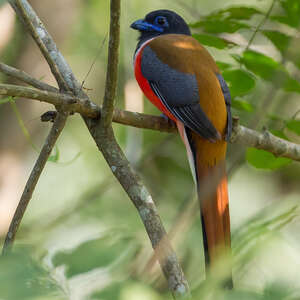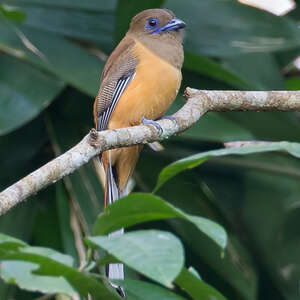Trogon de Malabar - Harpactes fasciatus - Malabar Trogon (original) (raw)
♂ adult
♀ adult
The Malabar Trogon derives its name from the Indian coastline situated between Goa and the southernmost point of India, Comorin. The scientific name of its subfamily Harpactes probably comes from the Greek word 'harpax' meaning 'rapace', 'ravisseur' or 'voleur', while 'fasciatus' is a Latin word meaning 'striped'. Is it the 'striped bandit'? The scientific name remains somewhat enigmatic; our Malabar Trogon is rather far from a raptor, but its diet which is mostly carnivorous and insectivorous may justify the name. There is a strong dimorphism, the male measuring 30 cm; its head, cap, nape and throat are the same anthracite colour, with a blue-cobalt beak and a black tip on both mandibles. The dark brown iris is surrounded by a wide circle of the same blue as the beak; this circle is a bit wider on the back part of the eye, and, most notably, there is a distinctive mark of the Malabar Trogon, a strip of blue skin that underlines the eye, giving it a strange smile. A very clear white line separates the anthracite chest from the reddish-carmine belly, the mantle is brownish-red and the back is shaded in chamois-gold; the bird looks less spectacular from behind but the colour palette is extremely fine with brownish-red shades. The scapulars, of the same colour as the mantle, stand out against the horizontally vermiculated black coverts with thin white wavy lines; the remiges are black with very clear white margins. The lower rectrices are black at their base and white in the majority of their surface; generally, the bird has a white tail crossed with a black line at its end when seen from the front. The female is no less charming but with a more discrete elegance: its head, nape and chest are light brownish-olive and the same blue-cobalt - perhaps slightly lighter - tinges the orbital circle as well as the beak with its black tip; the same blue skin line underlines the eye.A white patch separates the chest from the golden yellow belly, the mantle is fawn, the back is close to the golden yellow shade of the belly, the wings inspire artists with horizontal fawn vermiculations on a dark brown background. The remiges are black and highlighted with white at the margins. The underside of the tail feathers are white, showing black bases which can have a black line in the middle, the upper tail feathers are light brown-brown, barred with black at the ends. The supreme coquetry of both sexes are the blue tarses that match perfectly with the beak and eye! Juveniles look like their mother, the chest and belly are light fawn, the wings are lightly spotted in brown and light yellow, the young males not yet having their black and white wings. Two subspecies are recognized, fasciatus, only in Sri Lanka which gives its name to the nominate species previously described, and malabaricus, in India, which has a black head and is a bit larger with a longer tail.

